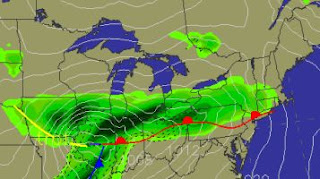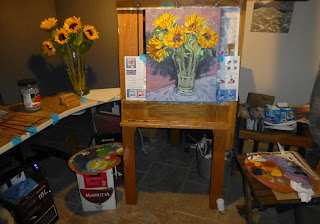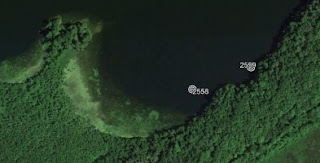 |
| #2570 "Cirrus Sunset from the Bottom of the Atmospheric Ocean" 11x14 |
Enjoying another Singleton sunset made me really ponder the orientation of these particular lines in the sky. The complexity of the patterns really emphasized that we do indeed reside at the bottom of a very deep and extremely dynamic ocean of air. The answers were not immediately obvious. I need to explain this sunset a bit. Observing from our Earthly viewing platform reveals the following. There were at least three bands of cirrus above Singleton with clear skies beyond them at least as far as the horizon. The western most cloud edge had to be a deformation zone but something was unusual. The sharp edge was on the western flank of the cirrus band and the moisture was to the east of the deformation zone. Gravity wind waves were embedded within the three swells of cirrus. Remember that long wavelength ocean swells propagate great distances from their windy source. I was attributing the three bands of cirrus as atmospheric swells. The drift of the cloud within the bands was from south so the atmospheric winds had to be southerly. Wind gravity waves embedded in the swells were consistent with the earth observation of southerly winds. Some faint ice crystal virga wafted toward the ground while catching the last rays of the setting sun. These trails of virga were in front of the cirrus swells from my vantage.
The dark sunset colours on the horizon was the glow of the setting sun catching dust in the boundary layer of the atmosphere stirred up by a daytime of wind and human activities. Smoke and the exhaust of industries from around the busy ports of the Great Lakes would easily explain those somewhat murkier colours.
To complete the diagnosis of the sunset sky, I would have to consult the view from space. The water vapour imagery confirmed the orientation of the deformation zone over Singleton. The weather story was even more complex. I was viewing just a small portion of a much larger double cyclonic deformation zone. That line in the sky was associated with an upper cyclone near Timiskaming and a second low well southeast of Cape Cod. Recall that double cyclonic and double anticyclonic deformation zones tend to be nearly stationary with respect to the globe. The next morning dawned cloudy and the satellite imagery confirmed that the pattern had retrogressed toward the west, bringing the overcast skies with it. The jet stream was in a highly meridional flow pattern consistent with that expected from a weakening flow associated with climate change.Satellite imagery reveals details and complexities that could keep professional meteorologists entertained for days. I know that from experience! Most people should not venture down that rabbit hole. Always remember that the atmosphere is a complex three or four dimensional flow. The area of the water vapour imagery where I sketched in the double-cyclonic deformation zone conceptual model, shows a stronger northeasterly flow actually sinking as it headed southward. The cyclonic x's were actually vortex tubes stretching through the depth of the atmosphere. The moisture over Singleton and the little yellow star is actually rising as it heads northward. This pattern was not moving far but was likely to shift to the southwest with the stronger winds.
The highly contorted flow revealed by the water vapour imagery, was typical of the wave number seven of the weakening jet stream. Instead of following the lines of latitude as a zonal, strong current of air, the jet stream was more likely to follow the meridional lines of longitude northward and then southward is a series of ox-bow lakes. That kind of pattern was over Singleton in that sunset sky and it told the story of climate change.This sunset weather story was unusual in that the weather was approaching Singleton from the east. The typical progression of weather from the west was upset and I think this would cause the viewer some anxiety although they might not really comprehend why. At one time, these strongly blocked and convoluted patterns were rare. The clouds always tell the truth even if humans might not like to hear it. I paint what I see and nature always makes sense even if it might take some effort to unravel the lines in the sky.
For this and much more art, click on Pixels. Thank you.
Keep you paddle in the water and warmest regards,
Phil the Forecaster Chadwick









































